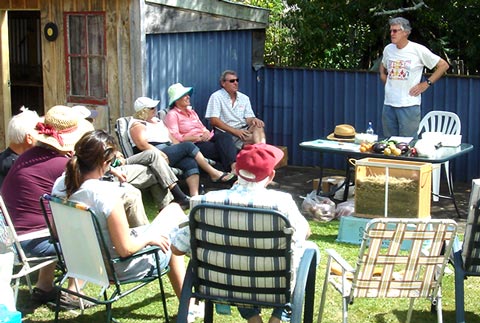How to Create a Successfull No Dig Garden [130 KB PDF]
Checklist [100 KB PDF]
PDF files require the free Adobe PDF Reader
 Comments on setting up and running community workshops based on our experience:
Comments on setting up and running community workshops based on our experience:
A team approach works best. If one individual does it all, they can burn out.
The key roles which can be split up are: teaching the technique, inspecting possible sites before hand for appropriateness, a contact person for registration and developing a database of e mail addresses and someone to handle promotion –getting articles in local newspapers and on community calendars.
- Registration
- Advance registration is essential. If too many individuals show up, it makes it difficult to teach well. Our experience is that 15-20 individuals is a good size and then put others on a waiting list. More individuals can be taught if there are multiple instructors. If 5 or less register, we cancel and shift them to a later date.
- Frequency
- We find that every 2-4 weeks is sustainable from spring through fall depending on demand and availability of instructors.
- Cost of workshops
- We charge $15 to make it affordable but we have heard of some communities charging $25-40. We also ask all participants to bring some organic materials to contribute. We often joke about them creating “potluck” gardens.
- When to offer and length
- two and a half hours on a Saturday morning or afternoon works well. My favorite time is 2- 4:30 PM.
- Role of host
- We ask the host/hostess to get most of the materials on site before the workshop. Most materials (cardboard, leaves, grass clippings) are free and the only cost is a bale of straw and some soil/compost mix. We provide the host with a checklist of what is needed. (See checklist below) Most hosts are willing to do this because they will end up with a nice garden bed.
